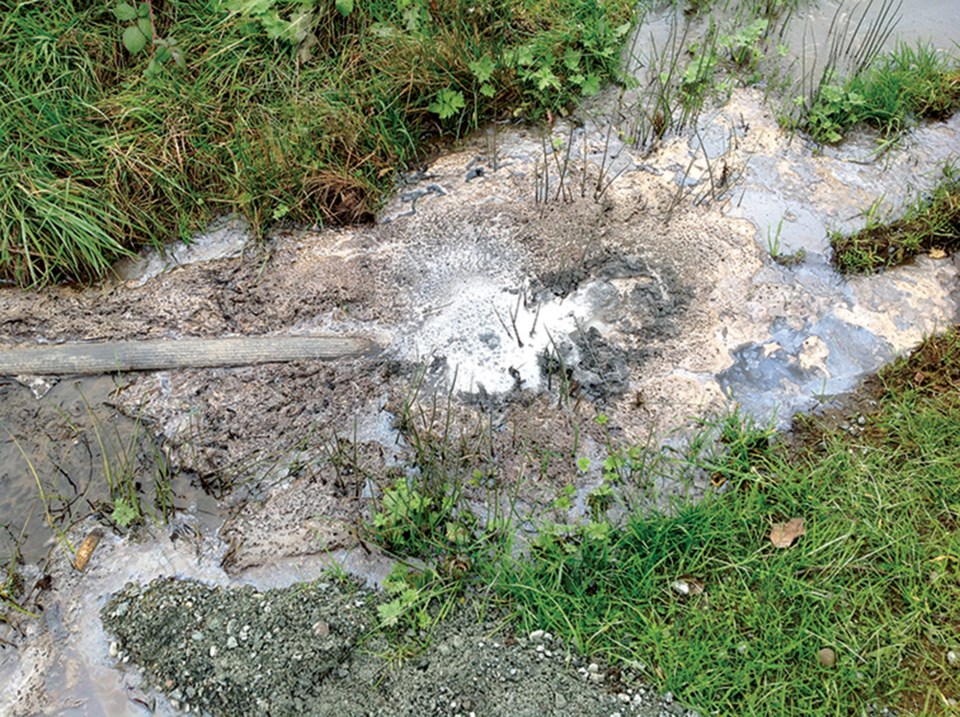One local resident is raising concerns about highway construction in the Burnaby Lake area and impacts on local wildlife habitat.
John Preissl alerted the NOW to some scum accumulating in a ditch next to a construction site at Glencarin Drive and Sperling Avenue, between Highway 1 and Burnaby Lake.
The oily, foaming substance was coming from a nearby pump that was emptying into the ditch along Glencarin Drive, which flows into Deer Lake Brook, the preferred habitat for the endangered Western painted turtle.
"It shouldn't be here. It's flowing right into the creek here. We've got salmon still in the creek," Preissl said. "It's really sad, this stuff."
Preissl alerted the City of Burnaby and was told they would come take a look.
"I can't believe they are letting this happen," Preissl said. "I'm disgusted."
Shortly after the NOW was onsite investigating, a worker arrived at the scene.
The NOW was told the material was naturally occurring, organic matter originating from peat beneath the ground, and even though it looked oily it was not harmful to wildlife. However, the employee did mention he would have water samples taken to make sure.
The NOW also spoke to Robin Taylor, an environmental manager with the Transportation Investment Corporation, which oversees the highway project. Taylor also said the material was organic in nature.
"It was ground water being pumped out to assist construction at another site nearby, right on the ramp," Taylor said. "It's basically got a fairly high organic content because it's water coming out of peat."
Taylor said the oily sheen was "a product of the natural decomposition of the materials in the water," and that the substance was not harmful to fish, wildlife or water quality.
"I don't know the chemical makeup of it, but it is a product of a natural biological decomposition," she said.
Even thought the ditch connects to Deer Lake Brook and the water was flowing in the direction of the creek, the scum is not getting into the natural waterway, according to Taylor.
"I did not see any evidence that is going into Deer Lake Brook," she said. "Once water is flowing, it basically breaks it up."
When asked about groundwater, Taylor said, "You want the water to soak into the ground, and that cleanses the water."
Taylor also said the pumping is now complete and was only temporary.
The federal government's controversial changes to the Fisheries Act came in effect Nov. 25. The previous act prohibited people from harming fish habit, while the amended act prohibits "serious harm to fish that are part of a commercial, recreational or Aboriginal fishery."
Former Fisheries and Oceans Canada biologist Otto Langer criticized the government's weakening of habitat protection, because if you don't have healthy habitat, you don't have fish. The water in the ditch did not appear full of sediment, which Langer said was particularly damaging for salmon, as it can smother eggs.
"It does tremendous damage. It's the biggest killer of salmon in the world," he said.
How to tell the difference between petroleum sheens and organic ones:
- Take a whiff. Bacteria-based, organic sheens don't have that distinct gas or diesel smell. They are often "humic" sheens caused by bacteria. (Humus is the organic compound in soil formed by decaying plant matter.)
- Look around. Is there an obvious source of petroleum that could have caused the sheen? Bear in mind, heavy rains often cause runoff from roads, parking lots and sidewalks.
- Poke the stuff. Break the oily surface of the water with a stick or a stone and watch what happens. If the sheen breaks up into platelets, it's probably natural. If the material tries to reform and moves back together to close the gap, then it's likely petroleum.
What to do about it:
- If you suspect the material is harmful to the environment, take pictures or video (if you have smartphone or camera) and be sure to show the surrounding area for context and to prove where the spill occurred. If you don't have a camera or smartphone, take notes.
- For Burnaby spills, call the city immediately at 604-294-7200. (In Vancouver, call 311.)
- The provincial emergency program has a 24-hour hotline for oil and hazardous material spills: 1-800-663-3456.
- After you've alerted authorities, call your local environmental reporter, Jennifer Moreau, at 604-444-3021. Reporting on these issues helps hold polluters accountable.



